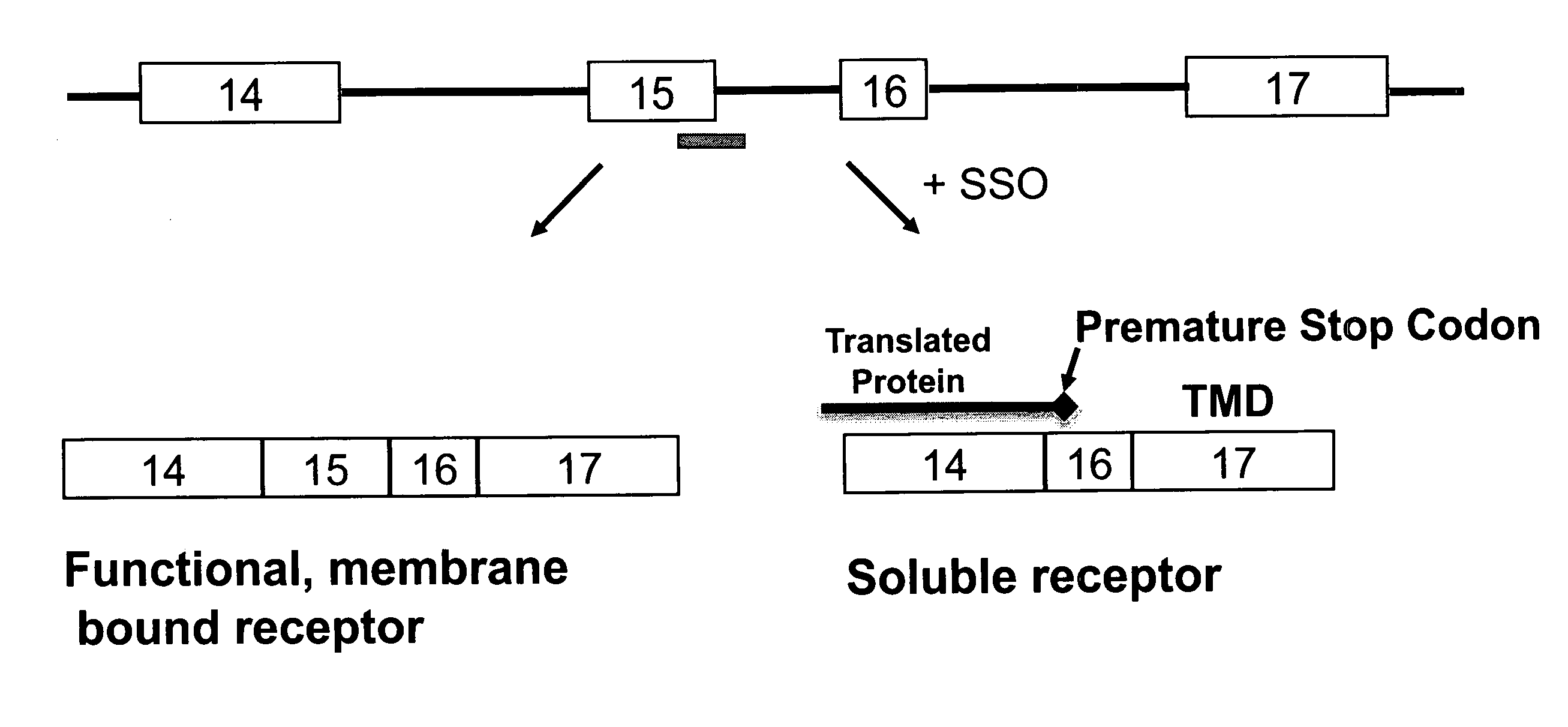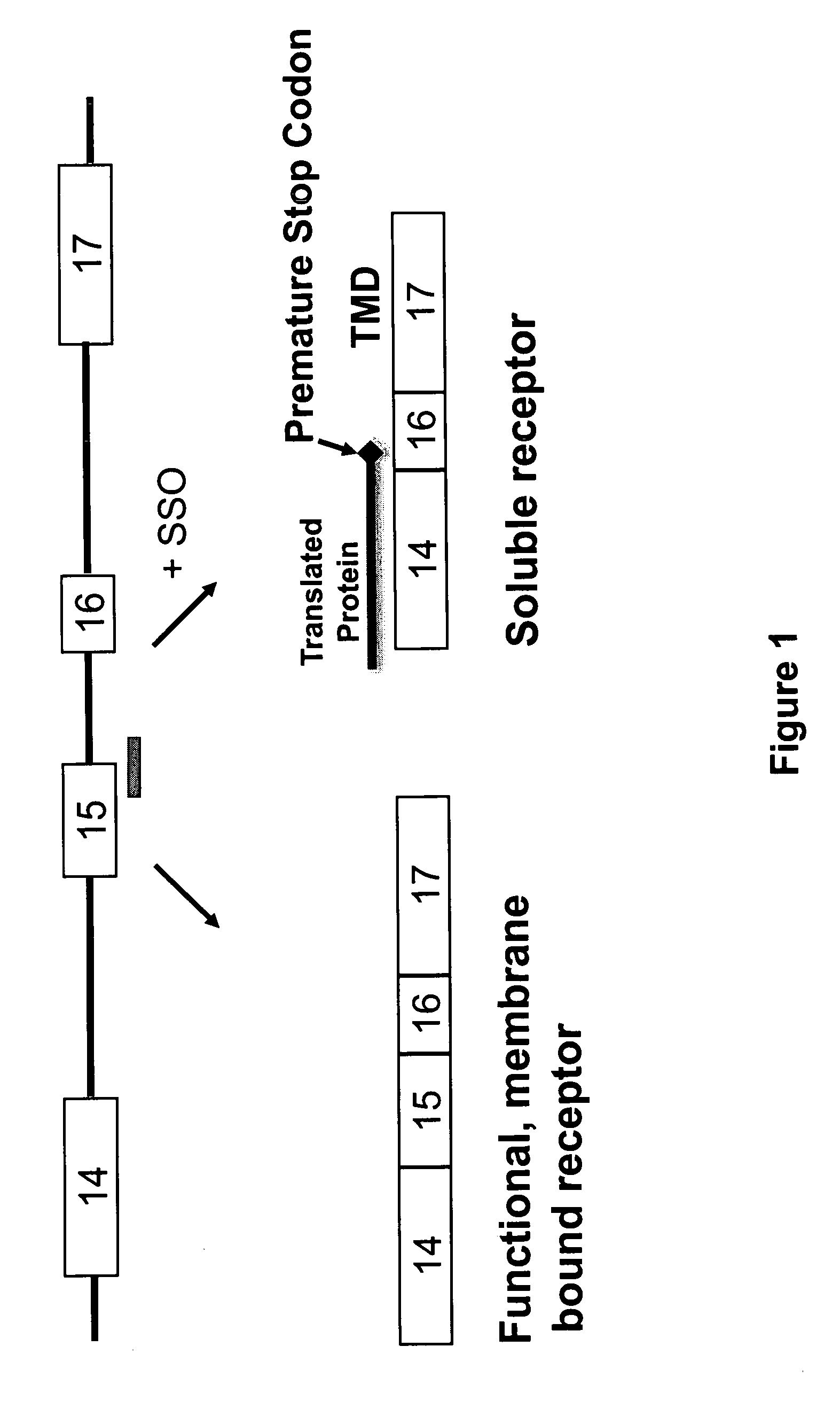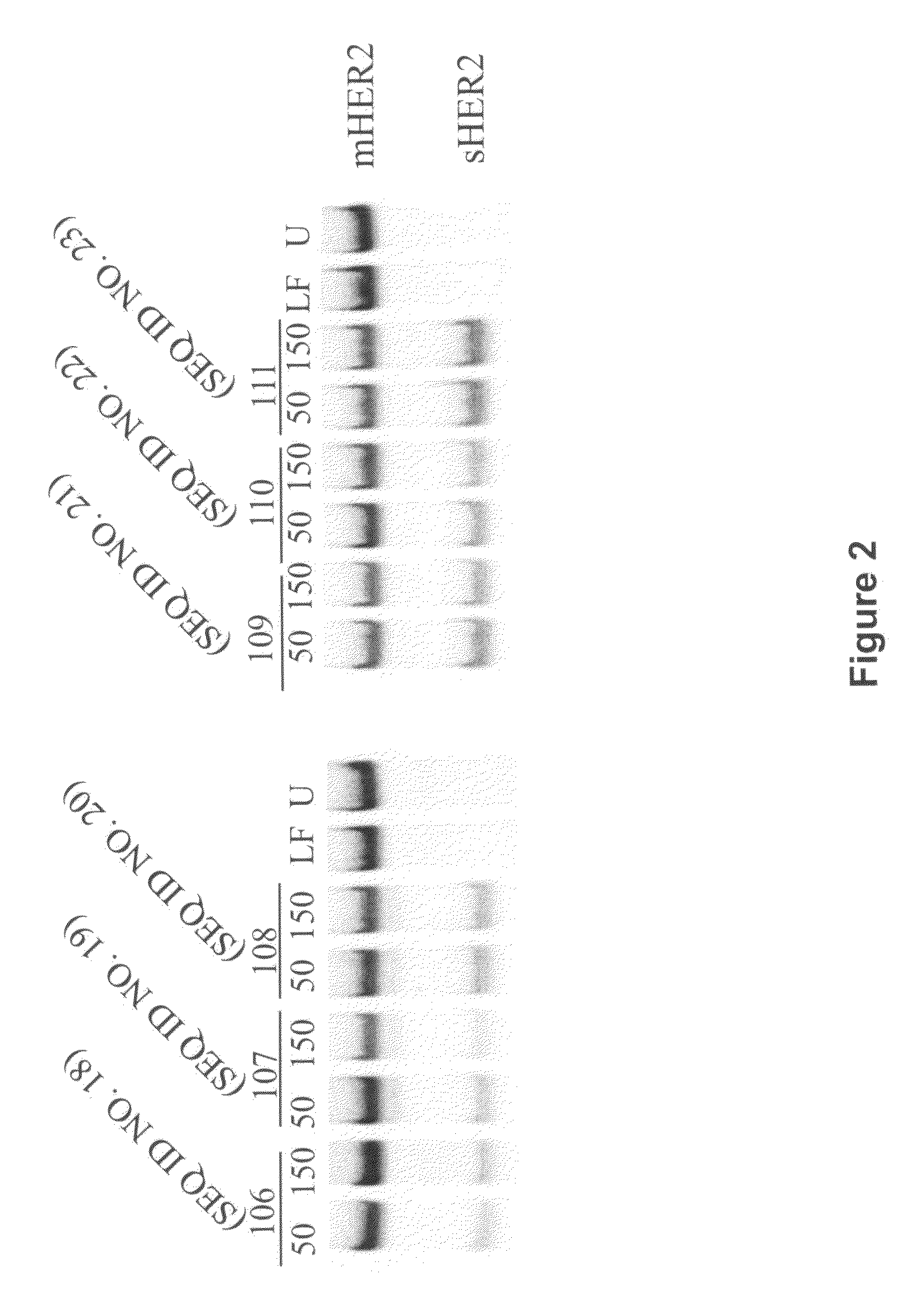Soluble HER2 and HER3 splice variant proteins, splice-switching oligonucleotides, and their use in the treatment of disease
a splice variant and splice technology, applied in the field of protein and nucleotide chemistry and biochemistry, can solve the problems of low cure rate, limited application range, and substantial adverse effects and resistance to certain therapies, and achieve the effect of improving the pharmacokinetics
- Summary
- Abstract
- Description
- Claims
- Application Information
AI Technical Summary
Benefits of technology
Problems solved by technology
Method used
Image
Examples
example 2
HER2Splice Variants
[0221]Exemplary splice switching oligonucleotides (SSOs) containing phosphorothioate internucleotide bonds and targeted to regions of human HER2 pre-mRNA (FIG. 1, Table 2) were synthesized.
TABLE 2Splice switching Oligonucleotides Targeted to HER2SEQ ID.NameSequence (5′-3′)ModificationActivity18106ggg cag aaa aga ttt gtg gg2′-OMe, PS+19107cac act ggt cag cct cct gg2′-OMe, PS+20108gcc aca cac tgg tca gcc tc2′-OMe, PS+21109ctc acg agt ggg tgc agt tg2′-OMe, PS+22110gtt gga ctc acg agt ggg tg2′-OMe, PS+23111gac cgt tgg act cac gag tg2′-OMe, PS+24M111gac cgt tgg act cac gag tgMOE, PS+25L111CgTtGgAcTcAcGaGtUpper case: LNA;+lower case:deoxyribose, PS2′-OMe, 2′-O-methyl oligoribonucleotide; MOE, 2′-O-methoxyethyl oligoribonucleotide; LNA, locked nucleic acid oligonucleotide; PS, phosphorothioate intemucleotide linkage.
[0222]These oligonucleotides were transfected into SK-BR-3 human breast cancer cells with the cationic transfection reagent Lipofectamine™ 2000 (Invitrogen) ...
example 3
HER3Splice Variants
[0228]Exemplary splice switching oligonucleotides (SSOs) containing phosphorothioate internucleotide bonds and targeted to regions of human HER3 pre-mRNA (FIG. 7, Table 3) were synthesized.
TABLE 3Splice switching Oligonucleotides Targeted to HER3HER3 TargetSEQ ID.NameSequence (5′-3′)SiteModification261GGGTCACTTCCAAGTCCTGAPutative2′-OMe, PSbranch site272GTCACTTCCAAGTCCTGACCPutative2′-OMe, PSbranch site283CACTTCCAAGTCCTGACCTTPutative2′-OMe, PSbranch site294CTTCCAAGTCCTGACCTTCAPutative2′-OMe, PSbranch site305CCCTTACTGTACCCATTCAG5′ splice site2′-OMe, PSof intron 13316CTCCCCTTACTGTACCCATT5′ splice site2′-OMe, PSof intron 13327TGGCTCCCCTTACTGTACCC5′ splice site2′-OMe, PSof intron 13338CTCGAGGCTCCCTGTAGTGG3′ splice site2′-OMe, PSof intron 13349ATTCTCGAGGCTCCCTGTAG3′ splice site2′-OMe, PSof intron 133510CAAATTCTCGAGGCTCCCTG3′ splice site2′-OMe, PSof intron 133611CTAGTATACCGAGCCATTGC5′ splice site2′-OMe, PSof intron 143712GTGCTACTAGTATACCGAGC5′ splice site2′-OMe, PSof intr...
example 4
Evaluation of Carrier Peptide Conjugated PMOs in the EGFP-654 Transgenic Mouse
[0231]A PMO (654; 5′-GCT ATT ACC TTA ACC CAG-3′; SEQ ID NO: 43) designed to restore correct splicing in the enhanced green fluorescent protein (EGFP) gene was conjugated to various carrier peptides (SEQ ID NOS:44-54) to produce peptide-conjugated PMOs (P-PMOs) and evaluated in vivo for their splice-correction activity and toxicity in the EGFP-654 transgenic mouse model (Sazani, P., F. Gemignani, et al. (2002) Nat Biotechnol 20(12): 1228-33). In this model, the EGFP-654 gene encoding for functional EGFP is interrupted by an aberrantly-spliced mutated intron, and cellular uptake of EGFP-654 targeted P-PMOs can be evaluated by RT-PCR detection of the restored EGFP-654 splice product in tissues.
[0232]Female EGFP-654 transgenic mice were injected intraperitoneally once daily for 4 consecutive days with saline or a 12.5 mg / kg dose of P-PMO. Post treatment on day 4, the heart, muscles, liver, kidney, lungs, small...
PUM
| Property | Measurement | Unit |
|---|---|---|
| Fraction | aaaaa | aaaaa |
| Fraction | aaaaa | aaaaa |
| Hydrogen bonding enthalpy | aaaaa | aaaaa |
Abstract
Description
Claims
Application Information
 Login to View More
Login to View More - R&D
- Intellectual Property
- Life Sciences
- Materials
- Tech Scout
- Unparalleled Data Quality
- Higher Quality Content
- 60% Fewer Hallucinations
Browse by: Latest US Patents, China's latest patents, Technical Efficacy Thesaurus, Application Domain, Technology Topic, Popular Technical Reports.
© 2025 PatSnap. All rights reserved.Legal|Privacy policy|Modern Slavery Act Transparency Statement|Sitemap|About US| Contact US: help@patsnap.com



